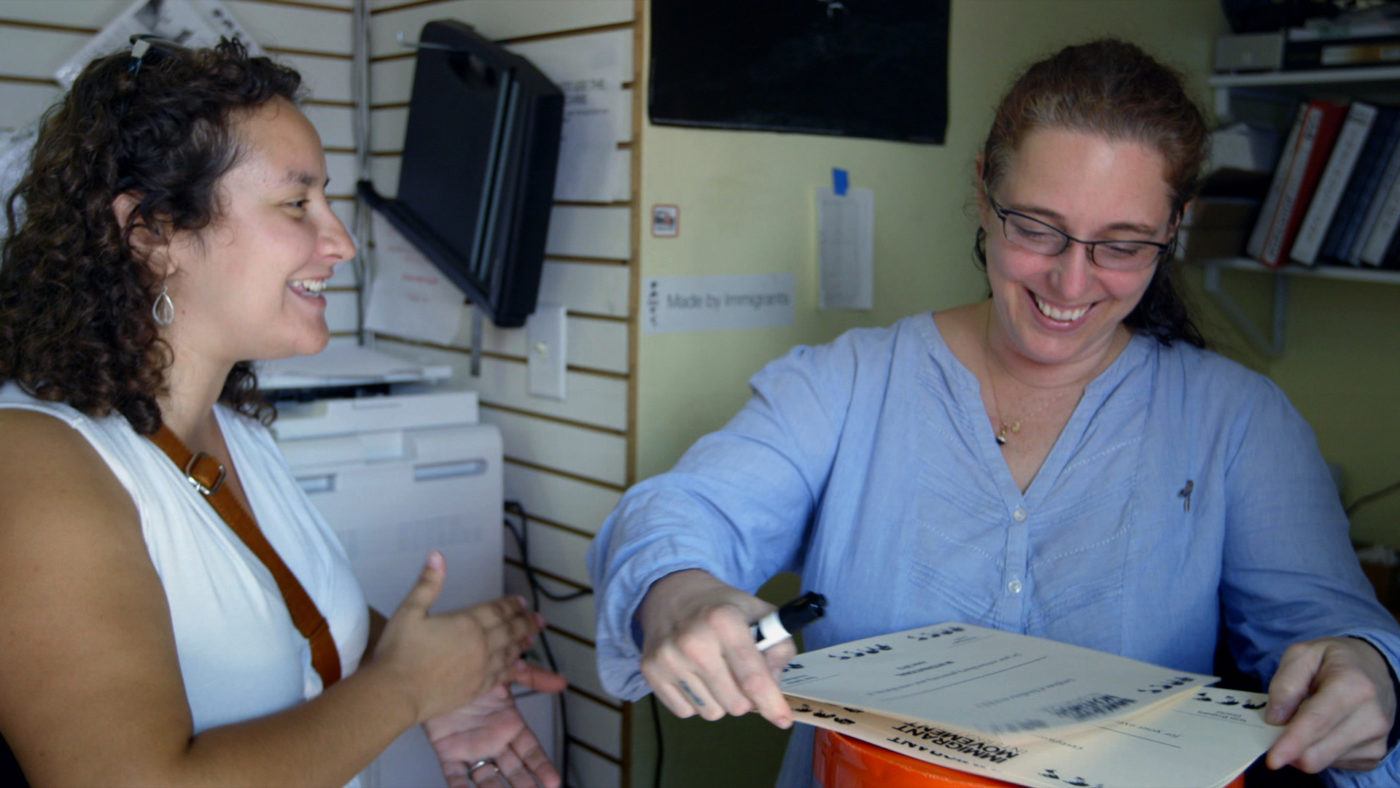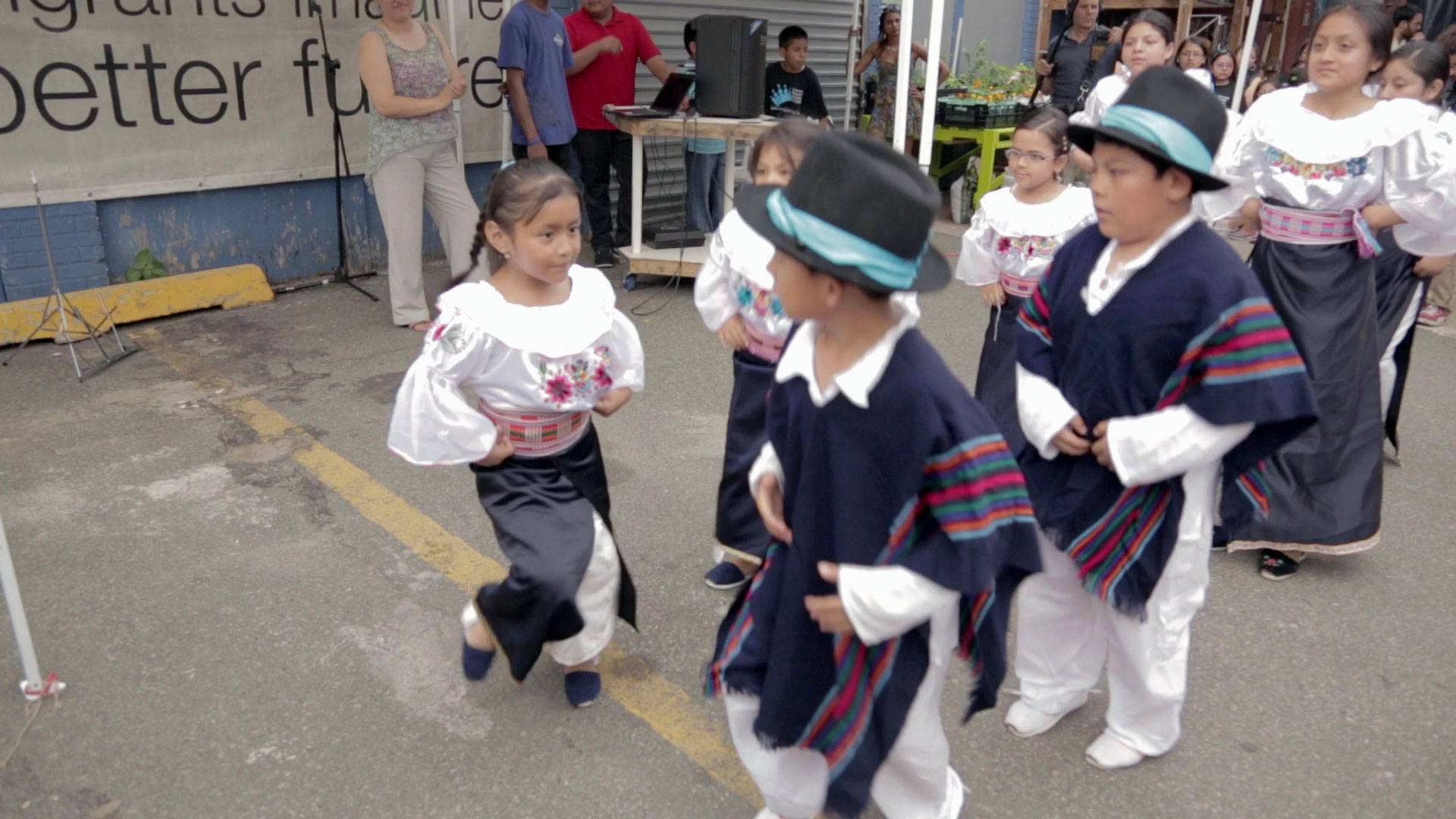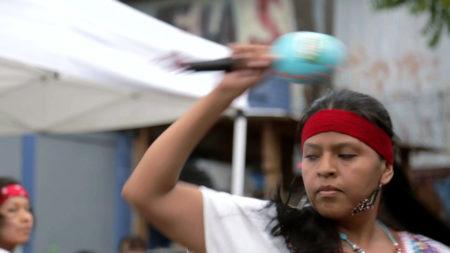Interview
Defining an Artist

Tania Bruguera, engaged with a collaborator during her Immigrant Movement International, 2014. Production still from the Art in the Twenty First Century Season 7 episode, Legacy. © Art21, Inc. 2014.
Tania Bruguera explains the term Arte Útil in relationship to the social responsibility of art. Interview by Susan Sollins at the Queens Museum in Queens, New York, on March 24, 2014.
ART21: Can you explain Arte Útil?
TANIA BRUGUERA: After working for a long time with political art and social art, I came to the realization that there are two kinds of artists. The first are those artists who think that, through art, they can unveil something that is happening in society, with people or whatever the subject is. These artists rely on the visual and the possibility art has to literally show us something.
The second kind of artist thinks they can do something with that knowledge and can use art as a tool for change. Arte Útil artists are not satisfied by just showing that there is a social problem or an inequality or by only telling you what’s going on. What gives them the aesthetic moment is [thinking about] how one can use all the tools of art to change reality and how to incorporate themselves as artists and civic servants into that reality, with the knowledge that art can change some of those paradigms.
ART21: What is your definition of an artist?
BRUGUERA: My definition of an artist is somebody who specializes in creativity, in knowing and acquiring tools by which they can imagine something different and make it happen in reality. Artists are people who are very good at imagining a thing and finding the way in which that can be built and exist for others. Basically [an artist is] somebody who doesn’t comply with what is happening at the moment. For a long time, artists were doing it for themselves and keeping it for themselves, [which leads to the] idea of the crazy artist or the bohemian artist. But now there are artists who have social responsibility: to share and to implicate other people in that dream and in that way of seeing reality.
ART21: What makes an artist who feels a social responsibility different from a person who works with groups of people to envision some kind of new future, like a politician or social scientist?
BRUGUERA: I think the difference between artists and scientists, politicians, professors, civic servants, or activists—other people who are trying to change things—is the fact that artists have much more freedom. Scientists have to work with certain truths; activists have to work with certain guidelines, ethics, or parameters in order to gain the trust of people. The artists do not need any of that. The artist is somebody who can participate in all of those activities; [being an artist is] not a specialized practice. The artist is somebody who can bring together people from other spheres to work in a vision of a different reality. The artist is the one who has to push the others to get away from their disciplinary boundaries.

Tania Bruguera, young participants of Immigrant Movement International, 2014. Production still from the Art in the Twenty First Century Season 7 episode, Legacy. © Art21, Inc. 2014.
ART21: We observed your Immigrant Movement International project in Queens. How do you explain that project to a viewer who sees it as a social-activist project, one that provides large groups of people access to tools that they wanted but didn’t have or couldn’t reach? How would you explain it as a work of art or a work that needs to be created by an artist?
BRUGUERA: An artist can bring [something] to the discussion of social change and working with others, like scientists, activists, teachers, or politicians. When people know art is involved, they lower their defenses, and they understand that it is a tradition of [art] to [be] about humanity and how human beings are in time and in place, without further interest—whereas they know that [a politician] is going to take something out of a conversation or is going to profit from whatever is happening.
It is not easy, as an artist, to collaborate with other people because there are some prejudices against what the role of the artist is and how artists have been situated in the political spectrum. Most people see artists as leftist, but they also don’t see artists as completely committed to political endeavors and issues because the relationship with the market creates some distrust.
Artists need to make people understand what the role of art is today and then show that to other people. Artists today should be not only about producing but also about being one effective part of another ecology.
I know everybody can imagine things, and anybody can have a vision, but I feel that artists are more eloquent in knowing how to pick what works and what has the idea of beauty. By beauty, I mean a landscape of ethics from very different places. An artist is like a sponge that is open to everything and anything, all the time, no matter if it comes from a physicist’s experiment, a lawyer’s case, or a politician. Artists have the capability to understand intuitively what can work and what can affect people because it’s in their nature to be extremely open to being susceptible.
Artists practice how one can be vulnerable in the world, to receive it and bring [something to] it. That gives a lot of freedom to the artist: to search instead of do a specific practice or follow a specific protocol.

Tania Bruguera, viewers of Tania Bruguera’s Immigrant Movement International, 2014. Production still from the Art in the Twenty First Century Season 7 episode, Legacy. © Art21, Inc. 2014.
ART21: If I met all those descriptions, then am I an artist?
BRUGUERA: If you’re open to being susceptible to what works and to find the moments in which things are catalyzed in a way that can concentrate a set of anxieties, accomplishments, desires, and projections in one action or one moment, then yes, you are an artist. You don’t need to be trained in a school; you just need to train yourself to be aware of what to do. The fact that you can see it makes you susceptible to understanding art. But an artist is somebody who sees, understands, and does something with all of that and shares it with other people or tries to advance it into another stage.
ART21: Would it be fair to say that you’re changing the definition of the word, art?
BRUGUERA: I don’t think I’m changing the understanding of art. I’m taking the work of people like Allan Kaprow, Joseph Beuys, and Marcel Duchamp and the writings of artists and theorists in performance art—all that I’ve been reading, seeing, and looking at—and saying what I’m seeing.
I created the idea of Arte Útil because I started traveling and seeing people doing things a little differently. They were in the same package, they were in the same bag, but they wanted to use art for something other than the fact that it exists as art.
ART21: Why do you think Arte Útil is art?
BRUGUERA: I think art is a state of things. It’s not a permanent condition, and it’s not something that is going to happen forever.
In the moment in which we are living, art should not be forever. It should be art for now and for the urgencies of today. I see the role of the artist at the moment as somebody who can propose [actions] to the rest of the people, whether that be creating an environment for something to happen or giving the tools to people to do certain activities on their own. A role we have now is showing to people: this is what we can do, these are the tools, take them. I see the artist as somebody who is providing a tool kit for people. If somebody who’s not an artist is doing the same thing, what is wrong with that?
ART21: Why then do you even have to call it art?
BRUGUERA: It’s important to call it art because people need to understand that what we do now, as artists, is that practice. It’s a way we can assure that art has a role in society. Artists can keep their freedom to say what other people might not be able to say—because they don’t have places to say it, or they work in certain fields where they cannot say it, or they are afraid, or they haven’t created an idea of what they are feeling.
It’s important to call all of this art to preserve the necessity of experimentation, of a space in which to try out ways of talking about things that we as a society might not have arrived at yet.
This interview was originally published in the Art21 publication, Being an Artist.
Interview: Susan Sollins. Editor: Tina Kukielski. Curatorial and Editorial Assistant: Danielle Brock. Copy Editor: Deanna Lee. Published: September 2018. © Art21, Inc.




